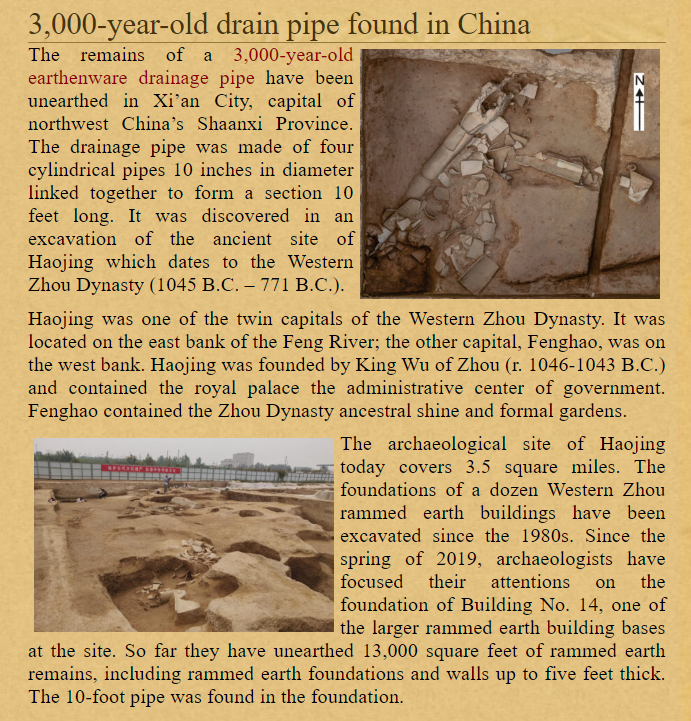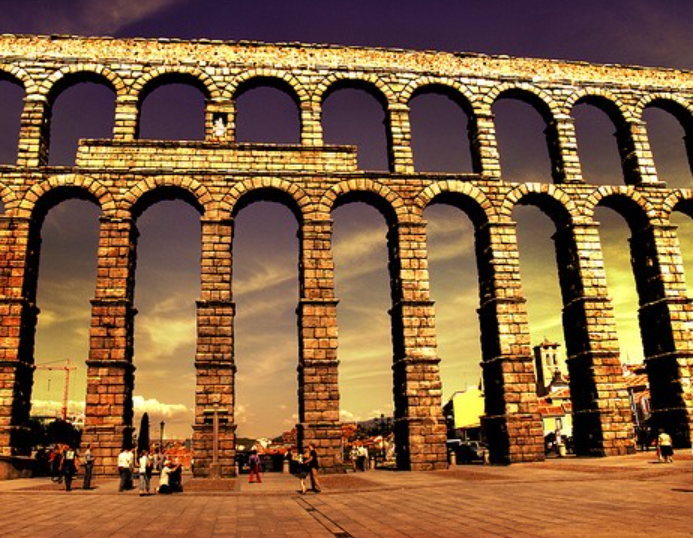Terracotta: a traditionally widely used material
Due to the easily moldable texture of clay (as opposed to marble or bronze) terracotta has traditionally been a widely used material that has been applied in many different ways over the centuries.
Nowadays, the baked clay is mainly used in clayware such as cooking utensils, flower pots, floor tiles and glazed wall tiles.
In previous era however, terracotta was used to depict religious figures as man in those days looked to the gods for guidance in daily life. Later on, divine themes were translated into various ‘heavenly’ decorated terracotta arts and crafts.
Terracotta has also been widely used in architecture: from 3.000 year old terracotta drainage piping found in China to Greek and Roman architecture and art works, to the ‘Basilica’ of San Vitale in Ravenna built in the 6th century, the Brick Gothic style of the 12th century, the Victorian Bell Edison building in Birmingham that was completed in 1896 up to the beautiful facade decorations in the 1800s that were first applied in serial production and later on produced in single, unique pieces.
Nowadays, terracotta is used in a climate-resistant sense as a sustainable and energy-efficient building material.
Religious applications of terracotta
Terracotta has been made since the Paleolithic era. There are countless religious human and animal figures, each of which had its own ritual or religious function within the various cultures in Southeastern and Central Europe, such as the figurines from Minoan Crete and the Pakistani goddess figures from the period 3000 BC. and 1500 BC. Also the in 3000 BC. terracotta works of art from Avanos in Turkish Cappadocia were made of clay from the river Kizilirmak that runs right through the city.
Later, in Greek antiquity (8th century BC), the Greek philosophy of bringing together the four earthly elements in terracotta (earth and water: the raw materials and air and fire: the firing process) was beautifully represented in the thorough and careful finishing and decoration of the Greek vase work. The stylization of natural motifs (Mycenaean vase work), the geometric and symmetrical figures (from the Geometric period) and the later Attic vase work, with which Athens in the 6th and 5th centuries BC. played a leading role in the production of terracotta, are typical examples of this. In India and China, terracotta was also seen in a philosophical light: the Indians were convinced of the beneficial effects of terracotta on the human body and such philosohical ideas could also be attributed to the immense Terracotta Warriors, which were given as a grave gift to the first emperor of China, Qin Shi Huangdi in the Iron Age (221 BC – 206 BC).
A more diverse application of terracotta can be found in the water nimphs used by the Romans between 150 and 175 BC. which were placed near fountains, the gliraria used for keeping and fattening dormice which were considered a delicacy at the height of the Roman Empire, and for artistic Campana reliefs from the 1st century BC. to mid-2nd century AD.
Since ca. 30 BC ‘terre sigillata‘, ancient Roman pottery with a glossy surface of clay slurry, was being manufactured in Arezzo (Tuscany). Mainly used in the western part of the Roman Empire for almost three centuries, this beautiful red earthenware utensils were made by hand, sometimes decorated with reliefs. Much later, in the Middle Ages, figurines of pipe clay and terracotta were frequently found in The Netherlands. In the same period, even children’s toys were made of terracotta, as the exhibition of the Museum of Antiquities in Leiden in 2010 so marvellously exhibited.
Terracotta in art and architecture
Terracotta has been used since the Bronze Age. Cylindrical terracotta pipes made on Santorini may have served for drainage purposes. The Romans used terracotta, which they had long known was far less dangerous than when drainage pipes were made of lead, to pump water to the fountains of their Minoan palaces. Also, in the same province of Shaanxi where the Terracotta Army was found, an earthenware drainage pipe was found that measured up to 10 feet per section.
Although the temples since the 6th century BC. were mainly built in sustainable natural stone following “the Greek structure as the most perfect structure”, terracotta has also been used in architecture over the centuries. Temples, churches and facade ornaments were covered with terracotta, both for constructive and for decorative purposes. The octagonal ‘Basilica’ of San Vitale church in Ravenna, considered one of the most important representatives of Byzantine art and architecture and commissioned in 521 by Theodoric, king of the Ostrogoths, was the first to use extruded hollow terracotta tubes for the construction of the dome. Later, this use of terracotta in architecture evolved into modern structural clay tiles to build roofing, walls and floors, especially in fire-resistant applications.
To a lesser extent, terracotta was used in the Greek Doric order. The forms of the traditional wooden construction were still present, but terracotta plates were only used for the cladding of the important parts and for the roofing. A good example of a Doric temple is the Temple of Hephaestus in Athens, where the columns are typical of Doric architecture. In Etruscan architecture, wood construction was also covered with terracotta roof tiles until the end of the 6th century BC, following the “Architectura” or “Ten Books on Architecture” by Marcus Vitruvius Pollio (ca. 25 BC).
During the Middle Ages little innovation was realized in the use of terracotta in European architecture. Even in the first monasteries that arose between the 5th and 11th centuries, for which the basilica (the Romanesque church with a transept as an addition to symbolize the cross) became the basic form, terracotta was not used noteworthy.
However, in Northern Europe in the 12th century, the use of red brick (washed and oxidised baked river clay containing iron oxide) took on importance. Not long after, the Brick Gothic style developed in Northern Europe within Gothic architecture, a style characterized by the lack of architectural sculpture (due to the local lack of natural stone types such as granite, basalt lavas, limestone, sandstone and marble) and the frequent application of creative divisions of walls, stone bonds, built-up ornaments and alternation of stone colors and plaster. Marienburg Castle or Malbork Castle in Poland is a fine example of Brick Gothic. It is the largest brick Gothic building. A typical example of the characteristic style in which brick masonry was interspersed with natural stone bacon layers is the St. Peter’s Church in Oirschot, The Netherlands, built in 1268, which is built in brick with tuff stone layers that give the church a striking appearance.
In the 13th century, tin glaze was first used as an opaque white background for Maiolica ceramics. The earthenware owes its name to the island of Mallorca, along which the trade in pottery between the producing Middle East and Italy took place. In the Renaissance, Italian maiolica was brought into production in several places in northern and central Italy. The type of pottery evolved into ‘faience‘ in France to make it resemble Chinese porcelain, where the tin-glaze base was covered with a translucent layer of glaze containing lead and tin oxides, which was then fired again.
It was not until the 20th century that innovative architectural applications for terracotta were seen again, for example as formwork for the concrete and for cladding walls, as used in the National Basilica of the Sacred Heart in Brussels.
Terracotta was also used in the construction of the 18th century Cathedral of St. Augustine in Florida, albeit limited to the terracotta tiled roof.
3000 year old Chinese terracotta drainage pipe found in China’s Shaanxi Province (Article & Photo The History Blog)
Roman Aquaduct built according to the “Ten Books on Architecture” by Marcus Vitruvius Pollio (Article & Photo: My Harvard Classics)
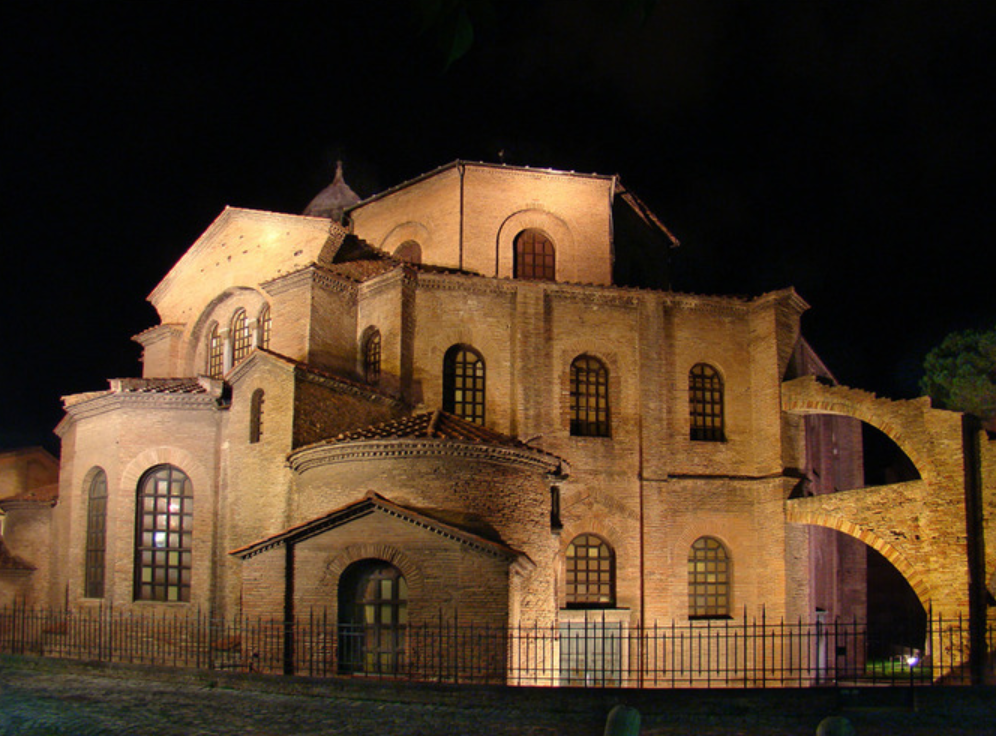
The ‘Basilica’ of San Vitale in Ravenna, Italy: a late antique 6th century Romanesque church originally built in octagonal shape with a central focus point but without transept, therefore -although temporarily; the transept was added in a later stage) deviating from the standard definition of a basiliqueL a church with a transept as an addition to symbolize the cross. The basilique with its rich mosaics in the presbytery is most famous as it is the only major church still intact from the period of the eastern emperor Justinian 1 (540 bC). (Basilique San Vitale Ravenna – Photo Boundless Resources)
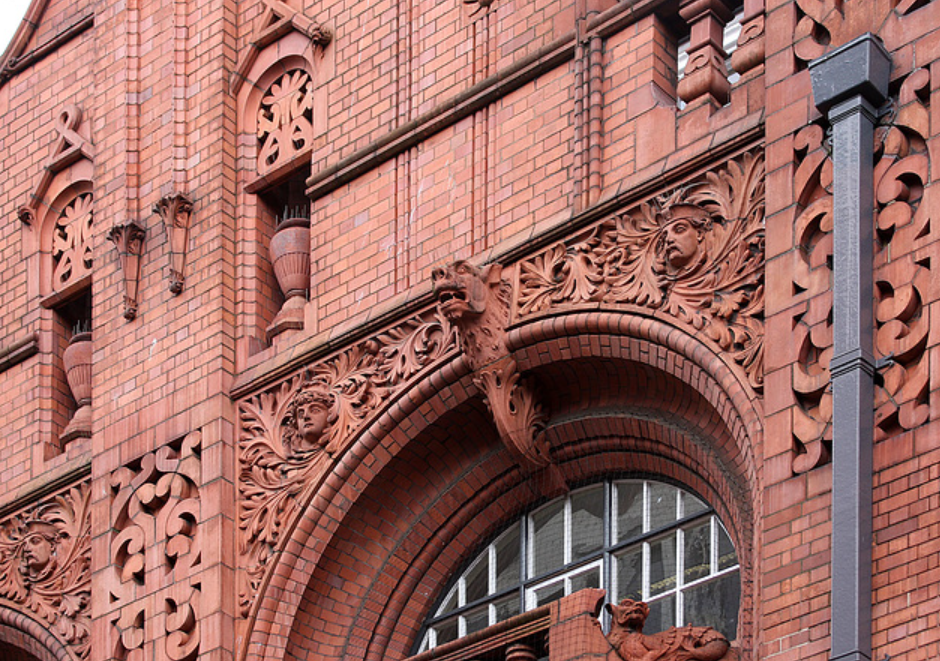
The Victorian Bell Edison Telephone Building in Birmingham completed in 1896 to the design of architect Frederick Martin of the firm Martin & Chamberlain. Whilst fairly plain at ground level, the upper storeys feature a rich variety of terracotta ornamentation. (Bell Edison Telephone Building in Birmingham – Photo Ipernity.com)
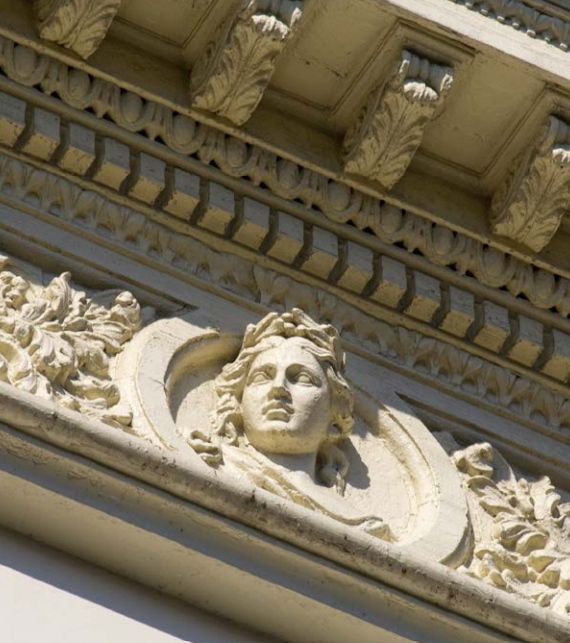
Terracotta facade decoration, Rijksdienst voor het Cultureel Erfgoed, Brochure October 2018 (download)
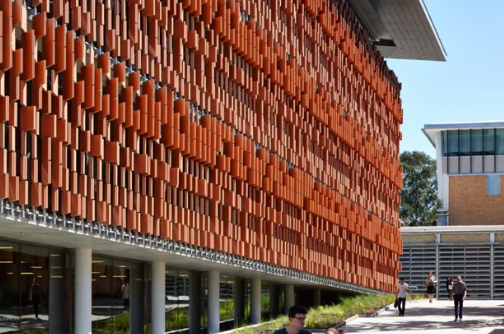
Terracotta flags used by the University in Brisbane as dynamic sun shades that moderate the heat load on the facade. (Article & photo Architectuur.nl)
Main sources for this article
- “Architectuur- en Bouwgeschiedenis in Perspectief: Bouwen en Bouwkunst in De Nederlanden en de westerse wereld”, Bart Verbrugge en Marcel Teunissen, 2018
- “Terracotta gevelversiering”, De Rijksdienst voor Cultureel Erfgoed van het Ministerie voor Onderwijs, Cultuur en Wetenschap, October 2018
- Boundless resources
- “Ripley’s believe it or not”
- “Roman architecture in the ages after“
Another very remarkable example of terracotta in architecture is the Victorian Bell Edison Telephone Building in Birmingham, built in 1896, whose detailed exterior, with balconies and carved arches above the windows, immediately catch the eye.
Decorative ornaments for facades made of terracotta were designed in 1839 by architect Willem Rose (1801-1877), government architect from 1858 to 1867 and city architect of Rotterdam from 1938 to 1855, based on the work of his German colleague Karl Schinkel (1781-1841). reintroduced. Decorative frames, decorative consoles and later cordon bands, caryatids, ornamented capitals and facing bricks were made with terracotta, which was much cheaper and more climate-resistant compared to natural stone, and other materials were imitated. Around 1900, more unique ornaments were made that were bricked into the facades to honor the ‘unity in the facade’ advocated by architects. Examples are the Peace Palace in The Hague, The Netherlands and the Scheepvaarthuis in Amsterdam, where sculptors worked on behalf of municipalities.
After 1930, due to the arrival of new raw materials such as Portland cement and the changing trends in architecture, the use of terracotta in facade ornaments declined.
Terracotta today
Today, terracotta is once again in the public eye and in architecture; hand-made or machine-made terracotta products such as facade cladding, sun protection made of terracotta ‘flags’ and floor and wall tiles are widely used because of the durability, climate resistance and energy-saving properties of the material.
The breathable and frost-resistant terracotta pottery has also made a ‘come back’. Terracotta flower pots supply the roots of plants with oxygen from the outside, which stimulates root growth, reduce the risk of rot and protect the plants against extreme temperatures. For this reason it is also possible to keep plants from southern areas such as olive, citrus and palm trees and oleanders or cacti in cold areas.
Most terracotta producers are now certified. An important aspect of this certification is the temperature at which terracotta is baked. In addition to oxidizing or reducing baking, which influences the final (red or grey) color of the product, baking at the right temperature and the length of the baking time are particularly important for resistance to temperature fluctuations and frost damage as a result of water absorption of the material.
Pottery, facade cladding and decorations and terracotta wall and floor tiles can therefore be manufactured in a guaranteed frost-resistant manner.
Terracotta: natural application as a solution for the current climate problems
Terracotta is baked earth or clay and therefore a natural material that is produced in an eco-friendly way without the addition of artificial or harmful substances.
The producers of terracotta often extract the clay from their own quarries, so there are no transportation costs to the production site. The baking of the often manually moulded products (each product is unique!) is largely baked in energy-efficient gas ovens.
To make it suitable for glazing and engobing (adding a clay-based suspension to which coloring oxides have been added to give bricks and roof tiles a shine), terracotta needs a low firing temperature, which means low energy costs.
The versatility and durability of the timeless terracotta make it suitable for many purposes. Think of sculpture and architecture such as facade ornaments, roof tiles and masonry, but also the ancient use of terracotta as cooking utensils and crockery. The use of terracotta as a floor tile requires little maintenance because terracotta has a high wear resistance. Terracotta floor tiles are sound-absorbing, available in various sizes and are finished with an anti-slip layer. It reduces energy costs due to the material’s ability to retain heat, especially when installed in combination with underfloor heating.
Due to the rising energy prices in the autumn of 2022, many people use stoves made from terracotta pots and ditto dishes, which are heated with a tea light. Whether heating in such a manner would be health-tricky remains to be studied further.
Unlike other materials such as wood, stone and other synthetic materials, terracotta is resistant to temperature fluctuations, so the risk of cracking is minimal.
As a result of the insulating effect of the material, the University of Brisbane has applied terracotta in the form of ‘flags’ as sun protection along the facade of the university building.
Terracotta is also fire resistant and therefore reduces the risk of fire. After the Chicago Fire of 1871, construction companies in Chicago used terracotta extensively in their projects.
It is also colorfast; the warm red or ochre-like color, which is determined by the burning of the lime and minerals such as iron in the clay during firing, does not change, even in prolonged bright sunlight.
When fired at the right temperature, terracotta, despite its water-absorbing capacity, is frost-resistant. Especially for pottery in the northern countries, this quality of terracotta is very much appreciated.
Recycling is another important aspect in relation to sustainability; with terracotta it can be done in a quick, easy and simple way. Terracotta therefore is cheap to reuse.
Finally, terracotta seems to accomplish a feeling of comfort and well being; a state of being of the highest importance to our lives!
